Planning a trip to Japan? We’ve got you covered! If you haven’t already, make sure to check out our comprehensive guide on the 60+ travel tips for Japan to get started. Now, let’s shift our focus to Osaka, the vibrant heart of Japan’s Kansai region.
Why does Osaka often top the bucket list for visitors to Japan? It’s simple: the city’s dynamic blend of modernity, rich history, and culinary excellence is a magnetic draw.
From indulging in the world-renowned street food in Dotonbori, exploring the futuristic cityscape of Umeda, to stepping back in time at the historical Osaka Castle, Osaka’s diverse attractions ensure that every visitor finds something to cherish.
Let us give you all the insider tips and essential information you need to navigate this lively city like a pro. So, strap in and get ready to explore the must-know Osaka travel tips that will make your journey truly unforgettable!
Top 38 Osaka Travel Tips
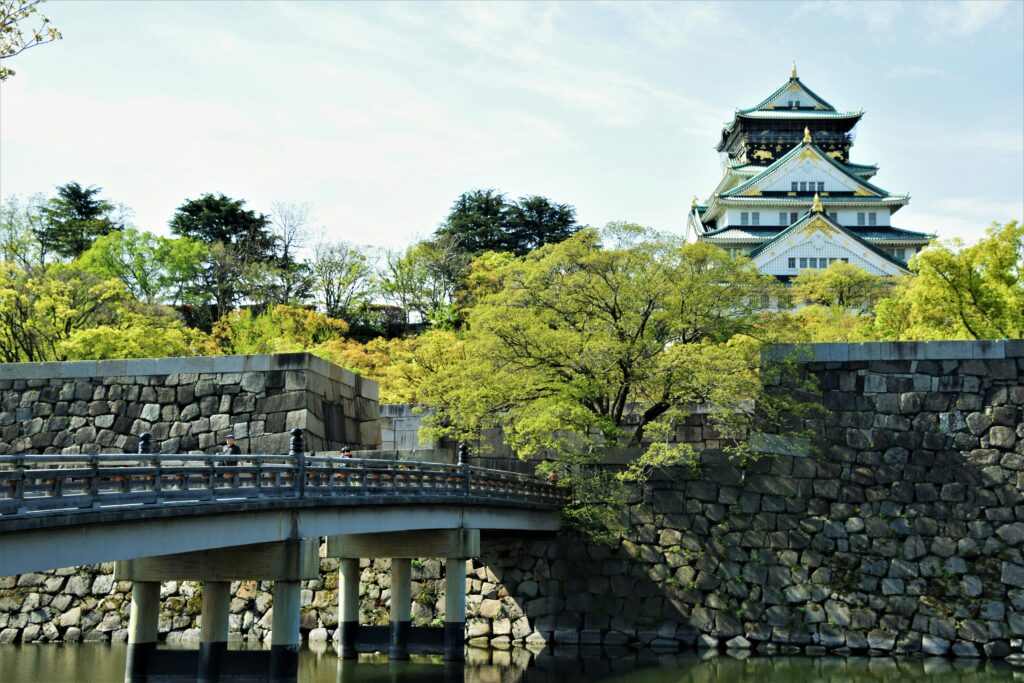
Travel Planning Tips
Before diving into the essential tips for Osaka travel, let’s set the stage for planning a trip to this vibrant and multifaceted city. Preparing for a visit to such a dynamic destination can seem daunting, but we’re here to guide you every step of the way.
Tip # 1: Book accommodations in areas that best suit your interests and purpose for travel.
For those looking to dive into the heart of Osaka’s hustle and bustle, the Namba area is ideal with its vibrant nightlife and shopping scenes. Conversely, travelers seeking a quieter, more relaxed experience should consider staying in Nipponbashi, known for its laid-back atmosphere and proximity to cultural spots.
Tip #2: Book accommodations early—especially during peak seasons like cherry blossom season, Golden Week, autumn, and the end of year/new year period. Each of these seasons has its unique draw but brings with it a higher number of visitors.
- Cherry Blossom Season (late March to early April): The blooming of cherry blossoms is a celebrated event across Japan. In Tokyo, spots like Ueno Park and Chidorigafuchi Park become especially crowded with both tourists and locals enjoying hanami (flower viewing parties).
- Golden Week (late April to early May): This is a series of four national holidays within one week and one of Japan’s busiest holiday seasons.
Many residents take paid time off during this period, leading to packed trains, airports, and tourist spots. Key dates include April 29 (Showa Day), May 3 (Constitution Day), May 4 (Greenery Day), and May 5 (Children’s Day).
- Autumn Foliage (mid-November to early December): Similar to the cherry blossom season, autumn brings stunning colors to Tokyo’s many gardens and parks. Popular spots for viewing autumn leaves, including the Rikugien Garden and Meiji Jingu Gaien, can be very packed.
- End of Year/New Year Period (late December to early January): New Year (Shogatsu) is Japan’s most important holiday. Many people return to their hometowns, and famous temples in Tokyo, such as Meiji Shrine and Senso-ji, attract millions of visitors for Hatsumode (the first shrine visit of the year).
Tip #3: Try to plan your visit during the least crowded and cheapest months:
- June (Rainy Season): Fewer tourists and generally lower prices can be expected due to the rainy weather, making it a quieter time to enjoy Hakone.
- Summer (July to August): Although it’s hot, the summer months tend to be less crowded compared to spring and autumn, potentially offering more comfortable pricing and accommodation options.
Tip #4: Download Google Maps – if you haven’t already. Google Maps is highly reliable and accurate in Japan. It provides real-time information on train schedules, platform numbers, and the best routes to your destination.
Simply enter your current location and destination, and Google Maps will offer detailed step-by-step directions, including walking paths within stations. Google Maps is widely trusted by both locals and tourists for its accuracy in Japan. It regularly updates to reflect any changes in train schedules or routes.
Tip #5: Consider timing your trip to coincide with the Osaka Castle Natsu Matsuri (Summer Festival) in July, the Tenjin Matsuri, one of Japan’s top three festivals, held in late July, the Osaka Kishiwada Danjiri Matsuri in September, or the Osaka Kani Doraku Crab Festival in winter. These events offer a deep dive into the local culture, cuisine, and community spirit.
Tip #6: Places like Osaka Castle, and the Dotonbori area can get very crowded, especially on weekends and holidays. To avoid the crowds (although I personally think that witnessing the huge crowd is part of the appeal of visiting Dotonbori, specifically!) and enjoy a more relaxed experience, plan to visit these attractions early in the morning.
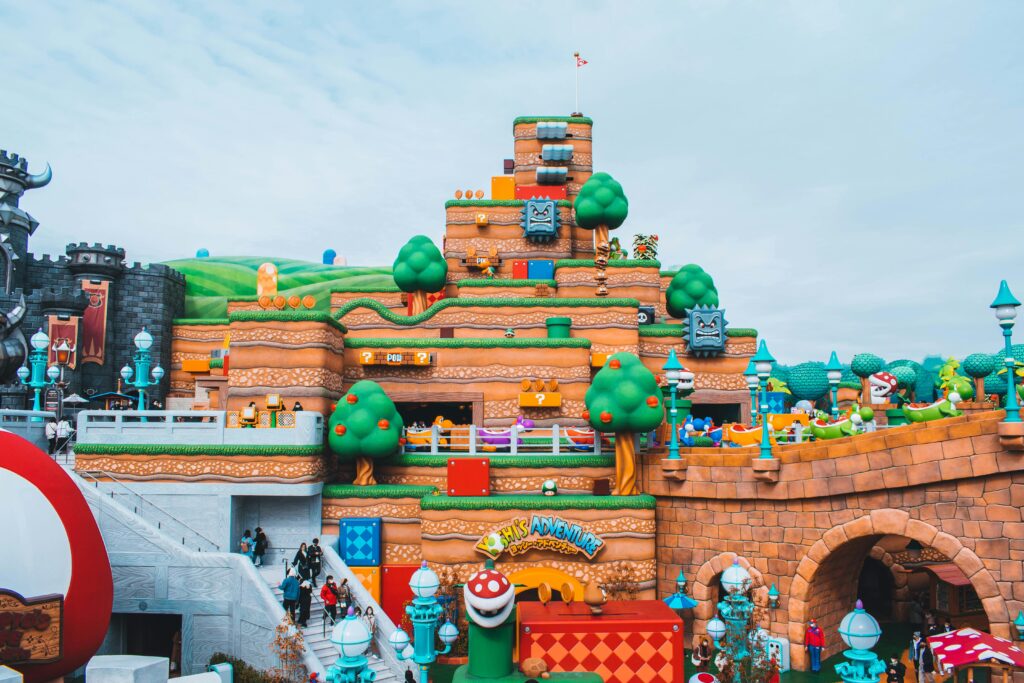
Tip #7: Especially if it’s your first time in Osaka, Universal Studios Japan is very likely in your itinerary. If so, you’ll want to optimize your experience at this wildly popular theme park. Here are some strategic tips to ensure you make the most of your adventure:
- Express Pass: Consider investing in an Express Pass, which will significantly reduce your wait times for popular rides and attractions. This can be particularly valuable during peak visitor times.
- Avoiding Peak Times: Try to schedule your visit on weekdays rather than weekends, and steer clear of Japanese school holidays, when the park is at its busiest. These typically include late March to early April (spring break), late July to late August (summer break), and late December to early January (winter break).
- Special Events and Shows: Universal Studios Japan is renowned for its seasonal events and special shows, which often include unique attractions and entertainment that are not available year-round. Check the park’s official website or app for the schedule of events before your visit to plan your day around these exclusive experiences.
- Early Entry: Arriving early can also make a big difference. Gates usually open before the official park opening time, allowing you to enter and position yourself closer to your must-see attractions before the crowds build up.
- Plan Your Route: Once inside, having a plan of attack is crucial. Decide in advance which rides and attractions are your top priorities and visit them first before the lines get too long.
Tip #8: Osaka’s river and canal systems offer a unique perspective of the city. Consider booking a river cruise along the Okawa River to see the city from a different angle, or explore the Dotonbori area by boat at night when the neon lights reflect beautifully on the water.
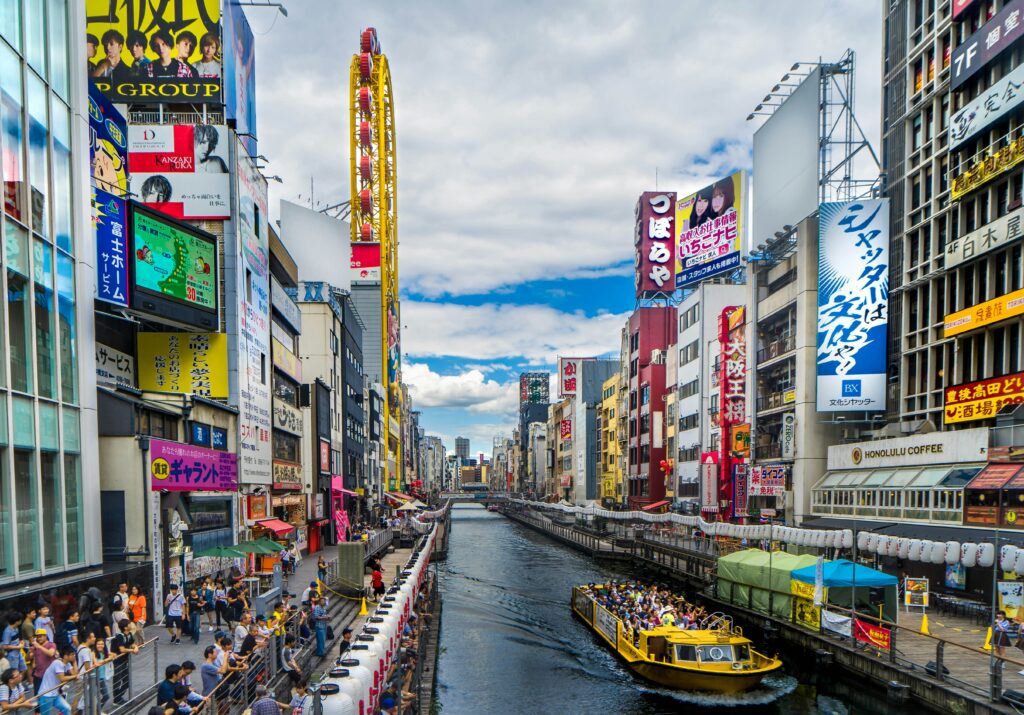
Tip #9: Consider joining a food tour or local experience to gain insider tips and enrich your visit. These tours not only provide a deeper understanding of the area but also support local businesses, tying into the services our company offers.
Tip #10: When planning your visit to Osaka, it’s important to manage expectations, especially regarding its cultural landmarks. Unlike Kyoto and Tokyo, which are famed for their extensive collections of ancient temples and shrines, Osaka offers a different vibe. Here’s what you should know:
- Osaka Castle: While a must-visit landmark, be aware that Osaka Castle has been completely rebuilt, and its interior has been converted into a modern museum. This may not appeal to those seeking an authentic historical experience similar to castles that have preserved their original conditions.
- Temples and Shrines: Osaka doesn’t boast as many traditional temples and shrines as Kyoto or Tokyo, but there are still some notable sites that are worth a visit:
- Shitennō-ji: Founded in 593 AD, Shitennō-ji is considered Japan’s first Buddhist temple and features a tranquil garden and a pagoda that can be climbed for a view of the surrounding area.
- Sumiyoshi Taisha: One of Japan’s oldest Shinto shrines, Sumiyoshi Taisha is famous for its distinctive, straight-roofed style and a serene setting that contrasts with the urban sprawl surrounding it.
- Osaka Tenmangu: This shrine is especially popular during the Tenjin Matsuri, one of Japan’s three major festivals, celebrated here with great pomp and spectacle in late July.
- Shopping and Urban Exploration: Osaka is often envisioned as a mirror to Tokyo’s extensive shopping districts and neon-lit streets.
While Osaka does feature bustling areas like Namba and Umeda, which are filled with shops and entertainment, the city generally has a more laid-back vibe compared to Tokyo’s often overwhelming buzz and size. The shopping districts are extensive but more manageable, and often less crowded, offering a different kind of urban charm.
Tip #11: Despite its bustling city vibe, Osaka’s main attractions can be fully experienced in just 1-2 days. This includes exploring the lively districts like Namba and visiting significant landmarks such as Osaka Castle.
However, after soaking in the city’s highlights, you can use Osaka as a convenient base for day trips to nearby cities. More details on these recommended day trips are provided in tip #, helping you craft a perfectly balanced exploration of Osaka and its surroundings.
Area Tips

Osaka is a dynamic city with a diverse range of neighborhoods, each offering unique experiences and attractions. Here are some area-specific tips to help you explore the distinct flavors of Osaka to their fullest.
Tip #12: Consider visiting some of the city’s most famous areas and tourist favorites.
Even if you’re not a fan of crowds, these incredibly popular spots are worth a visit for various unique reasons:
- Dotonbori: This area is the heart of Osaka’s nightlife and street food scene, renowned for the glowing Glico Man sign and its vibrant, bustling atmosphere. It’s a great place to try local dishes like takoyaki and okonomiyaki and enjoy the lively ambiance of the city.
- Umeda: Known for its impressive skyscrapers and shopping complexes, Umeda is a must-visit for anyone looking to experience Osaka’s modern urban vibe. The area is also home to the Umeda Sky Building, with its spectacular floating garden observatory offering panoramic views of the city.
- Namba: As another central hub of Osaka, Namba boasts a range of entertainment options, from shopping at Shinsaibashi to theater shows and lively bars. It’s a bustling area that captures the energetic spirit of Osaka.
Tip #13: If you’re looking to venture beyond the usual tourist paths in Osaka, several lesser-known neighborhoods offer unique local experiences:
- Shinsekai: Step back in time in Shinsekai, a neighborhood that retains a nostalgic feel of old Osaka. This area is celebrated for its retro charm, the iconic Tsutenkaku Tower, and its streets lined with vendors selling kushikatsu (deep-fried skewered meat and vegetables).
- Nakazakicho: For a quieter escape, head to Nakazakicho. This quaint neighborhood is known for its artsy atmosphere, featuring vintage shops and cozy cafes. It’s the ideal place for those seeking a more laid-back and creative environment.
- Tenma: Another gem is Tenma, renowned for its lively local market atmosphere. Tenma is packed with izakayas (Japanese pubs) and small eateries, making it a fantastic spot to mingle with locals and sample authentic Osaka cuisine.
Tip #14: If you have enough time, also consider taking these day trips from Osaka:
- Kobe: Just a short train ride away, Kobe offers a cosmopolitan atmosphere with its renowned beef, fashionable architecture, and the scenic harbor area.
- Nara: Known for its historic temples and friendly deer roaming freely in Nara Park, this ancient city provides a peaceful retreat from the energetic vibe of Osaka.
- Himeji: Another excellent day trip option is Himeji, famous for its stunning white egret castle, Himeji Castle, which is considered one of Japan’s most spectacular castles. The city offers a historical experience that contrasts nicely with the urban atmosphere of Osaka.
Tip #15: Beyond the main attractions, visiting local markets like Kuromon Ichiba can provide a deeper insight into everyday Osaka life, known for its foodie delights. Here, you can sample a variety of fresh foods, from seafood to street snacks, and observe local buying habits.
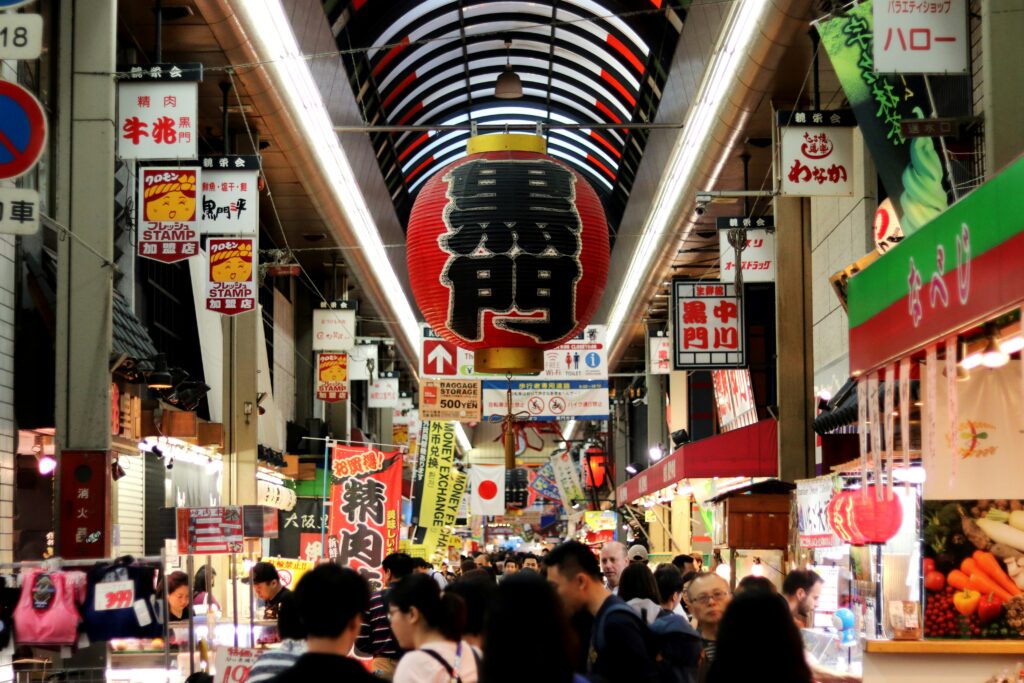
Tip #16: While Osaka is generally a safe city for travelers, like any major urban area, it has certain neighborhoods that are less advisable for tourists, especially when traveling with children. Here are a few areas where extra caution is recommended:
- Shinsekai: Despite its tourist appeal and retro charm, Shinsekai can feel a bit edgier, especially at night. The area around Tsutenkaku Tower is vibrant and bustling during the day but can attract a rougher crowd after dark.
- Airin District (Kamagasaki): This area is known for its high population of day laborers and a rougher street scene, which might not be suitable for families or those unfamiliar with urban environments. It’s not typically featured in tourist itineraries, but it’s good to be aware if you find yourself exploring off the beaten path.
- Nishinari: Similar to Shinsekai, Nishinari is known for its cheaper lodging options and is often frequented by budget travelers. While it offers an authentic slice of Osaka life, its gritty nature might not be comfortable or safe for all travelers, particularly at night.
While these areas can provide interesting cultural insights, they should be visited with caution, and perhaps avoided during nighttime to ensure a safe and enjoyable trip to Osaka. Always keep personal belongings secure and stay aware of your surroundings, especially when with children.
Culture and Etiquette tips
Navigating Osaka’s diverse neighborhoods involves understanding the unique cultural nuances of each area. Here are some tailored tips to help you adapt to the cultural landscape of Osaka:
Tip #17: In business and upscale shopping districts like Umeda and Namba, it is advisable to dress neatly and act with decorum. These areas are bustling hubs of commerce and socializing, where a more polished appearance and polite behavior are appreciated.
Keep your voice moderate in volume and be courteous with shop staff and dining personnel. Punctuality is particularly respected, so make sure to be on time for any reservations or meetings.

Tip #18: In traditional areas such as Osaka Castle Park and the historic district of Shinsekai, you should show a heightened level of respect. While visiting cultural sites like temples or historic landmarks, dress conservatively and observe all local customs and rules. These gestures of respect not only reflect well on you as a visitor but also help preserve the dignity of these culturally significant places.
Tip #19: For more casual and youthful experiences, head to districts like Amerikamura and Dotonbori. These areas are known for their vibrant street life and casual, eclectic atmosphere. Here, the dress code is more relaxed, and the environment generally supports a more expressive style.
While it’s fine to enjoy the lively scene and perhaps dress more informally, remember to maintain basic politeness and be mindful of your surroundings, especially in crowded settings.
Tip #20: When exploring residential or quieter neighborhoods such as Nakazakicho, take care to respect the local community by keeping noise to a minimum and observing local practices, such as sorting trash correctly if eating on the go. These areas offer a glimpse into the everyday lives of Osakans and should be treated with consideration.
Tip #21: Osakans are famously blunt and straightforward, a trait that is often perceived as refreshing honesty. When interacting with locals, don’t be surprised by their directness—this is a standard way of communication here and is not meant to offend.
This manner is especially evident in local markets and restaurants, where vendors and staff might seem more outspoken compared to other parts of Japan. Embrace this aspect of Osakan culture as it reflects their lively, down-to-earth nature. Understanding this can enhance your interactions and even lead to more engaging and genuine exchanges.
Tip #22: When walking in Osaka, remember that the local custom is slightly different from Tokyo and the rest of Japan. In Osaka, it’s customary to stand on the right and walk on the left on escalators and sidewalks. This is the opposite of what you might experience in Tokyo, where people generally stand on the left and pass on the right.
Tips Related to Transportation and Getting Around
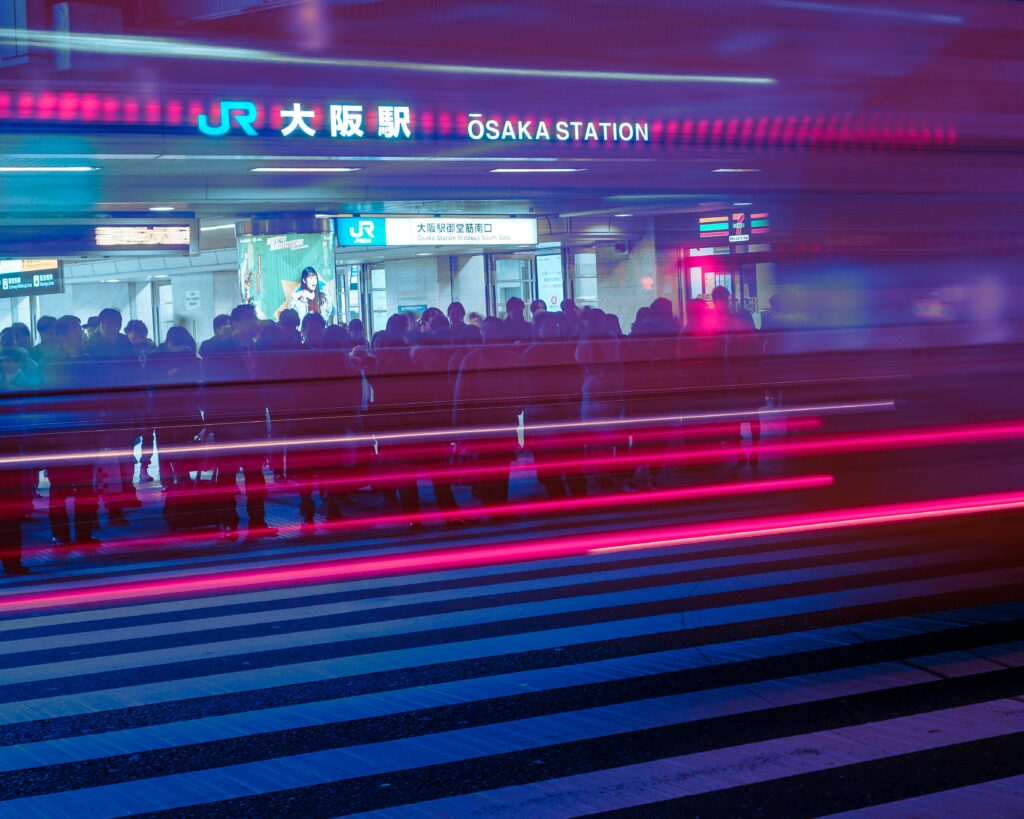
Navigating Osaka can be a smooth and efficient experience with the right know-how and preparation. Here are some practical tips for getting around the city using its extensive transportation system:
Tip #23: If you already have an IC card like Suica from your travels in other parts of Japan, you won’t need to purchase a separate card for your stay in Osaka. Suica, along with other cards such as ICOCA and PiTaPa, works seamlessly across Osaka’s extensive network of trains, subways, and buses.
These rechargeable smart cards are not only essential for smooth and efficient travel throughout the Kansai region but are also convenient for making purchases at many convenience stores, vending machines, and even some restaurants. This makes navigating and enjoying Osaka both simple and hassle-free.
Tip #24: Avoid rush hours if possible: Osaka’s rush hours typically occur from 7:30 AM to 9:00 AM and from 5:00 PM to 7:00 PM. During these times, public transport can get extremely crowded, particularly on main lines such as the Midosuji Line which connects major areas like Umeda and Namba.
Utilizing apps like Google Maps to plan your travel can help you find less crowded routes or optimal travel times.
Tip #25: Also know in advance that these specific train lines that tend to be busy:
- Midosuji Line: It’s the primary subway line running north to south, connecting major hubs like Shin-Osaka, Umeda, Shinsaibashi, and Namba. This line can be particularly busy during peak times.
- JR Osaka Loop Line: This line circles the city and is a convenient way to access different parts of Osaka, including Osaka Castle and Universal Studios Japan. It can also get crowded, especially near major stations.
- Hankyu Line: Connecting Umeda with Kyoto and Kobe, this line is heavily utilized, especially during weekends when people travel for leisure.
Tip #26: If you do find yourself stuck in crowds while using public transport, navigate it like a pro by:
- Adapting to the local flow by moving efficiently and quickly, especially on crowded platforms and trains.
- Standing to the side on escalators, typically on the right in Osaka, to let others pass if they’re in a hurry.
- Utilizing women-only cars during peak hours for a more comfortable commute.
- Keeping luggage compact and out of the way to facilitate easier movement through stations and onto trains.
Tip #27: Explore Osaka by bike. With a relatively flat topography, Osaka is conducive to cycling.
The city offers several bike rental services, such as the Osaka Bike Share, where you can pick up and drop off bicycles at various locations. This is an excellent way to see the city at your own pace and access areas that are less reachable by public transport.
When renting a bike, be mindful of these safety tips and cycling etiquette:
- Always ride on the left side of the road and follow traffic signals.
- Use designated bike lanes where available and be mindful of pedestrians on shared paths.
- Wear a helmet for safety, even though it’s not mandatory.
- Park your bike in designated parking areas to avoid fines or having your bike impounded.
Tip #28: Utilize Taxis for short distances and convenience. Taxis in Osaka are known to be expensive, so they are best used for short distances, late-night travel, or emergencies. Google Maps can provide fare estimates for your journey. Instead of getting an Uber, it’s also super easy, safe, and convenient to hail down a taxi the traditional way.
- Taxi Availability: Look for taxis with a green light indicating they are available. You can also use taxi-hailing apps like JapanTaxi or Uber, which are integrated with Google Maps for easy booking.
- Payment: Many taxis accept Suica or PASMO cards as well as credit cards, making payment convenient.
Tip #29: Consider taking advantage of the Osaka Amazing Pass. This pass not only provides unlimited use of public transportation within the city but also includes free entry to numerous attractions like Osaka Castle, Umeda Sky Building, and the Tempozan Ferris Wheel. It’s an economical choice if you’re planning extensive sightseeing. Here are some basic info about the pass:
- Types and Cost: ¥3,300 for a one-day pass.
- Transportation: Provides unlimited travel on the Osaka Metro, Osaka City buses, and additional private rail lines like Hankyu, Hanshin, and Nankai within the day, and not 24 hours from first usage.
- Attractions: Grants free entry to over 40 attractions including Osaka Castle, Umeda Sky Building, and Tsutenkaku Tower.
- Purchasing Locations: Can be bought online with a voucher exchangeable at places like the Kansai Tourist Information Center at Kansai International Airport.
- Additional Benefits: Includes discounts and special offers at various facilities and stores across Osaka.
Packing Tips
Packing for Osaka also requires careful consideration to adapt to its varied climate and urban environment. Here are some packing tips for your trip to Osaka:
Tip #30: Make sure that you pack appropriately for the season.
- Spring (March to May): The weather can fluctuate. Pack light layers like a cardigan and consider bringing a raincoat or umbrella, as spring showers are common.
- Summer (June to August): It’s hot and humid. Opt for breathable fabrics such as linen or cotton. Include items like a portable fan, sunglasses, and a wide-brimmed hat to protect against the sun.
- Autumn (September to November): The weather is mild and comfortable. Layering is key, so include items like light sweaters and a comfortable jacket.
- Winter (December to February): It gets cold, but not extremely so. Bring warm clothing like sweaters, a coat, and perhaps a scarf and gloves for chillier days.
Tip #31: Prepare for air-conditioned environments and indoor/outdoor transitions. With places like the expansive Osaka Aquarium Kaiyukan and the vibrant outdoor Dotonbori area, be ready for a variety of environments. Pack a versatile jacket that can keep you warm in chilly air-conditioned places and comfortable outside.
Tip #32: Sudden showers are not uncommon in Osaka, particularly during the rainy season (June and early July). A compact, foldable umbrella is essential.
Tip #33: Osaka involves a lot of walking. Comfortable walking shoes, such as supportive sneakers or cushioned flats, are crucial. For evenings out or more formal venues, consider packing a dressier pair of shoes as well.
Tips for After Arriving in Osaka
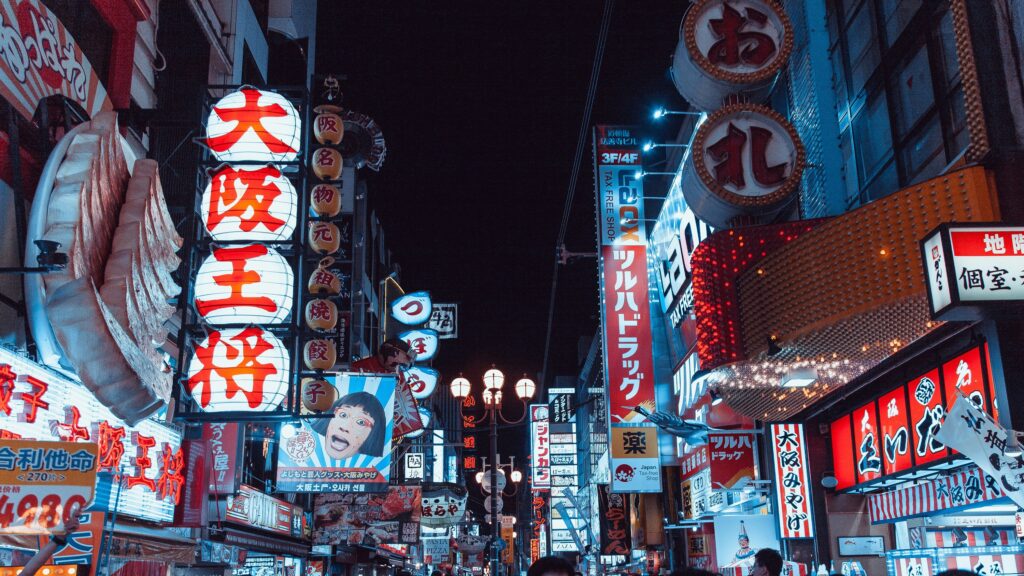
Arriving in Osaka is an exciting moment, but it can also be daunting. To help you settle in quickly and start your adventure smoothly, here are tips for your first few hours in the city.
Tip #34: Find your way out of Kansai International Airport (KIX) and into Osaka with these options:
- JR Haruka Express: This is one of the fastest and most direct ways to reach central Osaka. The Haruka Express runs from KIX to Shin-Osaka and Osaka Stations in about 50 minutes. Fares are around ¥2,850.
- Frequency: Trains run every 30 minutes during peak times.
- Nankai Railway: The Nankai Airport Express and the Limited Express Rapi:t offer services to Namba Station, a central hub in Osaka. The journey takes about 35-45 minutes, with fares for the Rapi:t at around ¥1,450.
- Frequency: Trains run every 15-20 minutes during peak times.
- Bus Services: Several limousine buses connect KIX with various destinations in Osaka, including major districts like Umeda and Namba.
- Fares: Depending on the destination, bus fares range from ¥1,100 to ¥1,550.
- Frequency: Buses run frequently, especially during the day.
- Taxis: Taxis are available 24/7 outside the terminals. While they offer door-to-door service, they are significantly more expensive than trains or buses.
- Fares: A taxi ride to central Osaka can cost between ¥15,000 and ¥20,000, depending on the distance and traffic.
Tip #35: Find your way out of Osaka International Airport (Itami) and into Osaka with these options:
- Bus Services: Buses from Itami Airport provide direct access to major parts of Osaka such as Umeda and Namba at a lower cost than taxis.
- Fares: Typically around ¥650.
- Frequency: Buses run approximately every 20 minutes during peak times.
- Taxis: Convenient for direct travel to your destination within Osaka, especially if you’re carrying a lot of luggage.
- Fares: Around ¥5,000 to central Osaka locations like Umeda.
Tip #36: Exchanging currency in Osaka can be straightforward if you know where to go:
- Airport Currency Exchange: Both Kansai International and Itami airports have currency exchange counters. While convenient, they may offer slightly lower exchange rates compared to city options.
- ATMs: Many ATMs in Osaka, located in convenience stores like 7-Eleven and Lawson, accept foreign cards and offer competitive exchange rates. Using an ATM can be a convenient way to withdraw yen directly.
- Currency Exchange Centers: Dedicated currency exchange centers in tourist-heavy areas like Namba and Umeda often offer better rates than airports. Look for branches or local exchange shops for good deals.

Tip #37: Japan, in general, is no doubt a foodie’s paradise, but Osaka is known as Japan’s kitchen for a reason! Dive into the local culinary scene by trying must-eats like takoyaki (octopus balls), okonomiyaki (savory pancakes), and kushikatsu (deep-fried skewered meat and vegetables).
Tip #38: Upon arriving in Osaka, take the opportunity to explore the diverse neighborhoods and their culinary offerings. While the city boasts many famous and viral restaurants, don’t hesitate to wander off the beaten path.
As you discover different areas, you’ll likely stumble upon local spots that are less frequented by tourists but highly cherished by residents. This exploration not only enriches your experience of the city but also allows you to taste authentic Osakan cuisine as locals do.
Ready to Explore Osaka?
With these 38 tips in hand, you’re all set to experience Osaka like a local. From savoring the culinary delights of Dotonbori to taking in the breathtaking views from the Umeda Sky Building, you’re in for an unforgettable adventure in Japan’s vibrant food capital.
Remember, the journey doesn’t end here. Dive into our other guides for insights on Kyoto, Tokyo, and beyond. Each city offers its own unique magic waiting to be discovered. Enjoy your travels and happy exploring!


Recent Comments